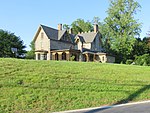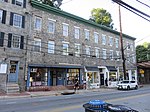Sheppard Pratt at Ellicott City

Sheppard Pratt at Ellicott City was a private psychiatric hospital located in Ellicott City, Maryland. It had a 20-bed adult unit, an 18-bed co-occurring disorders unit, an 18-bed crisis stabilization unit, a 22-bed adolescent unit, and an adult day hospital. The hospital was owned and operated by the Towson, Maryland based Sheppard Pratt Health System Prior to its purchase by Sheppard Pratt the facility was known as Taylor Manor, one of only a dozen privately owned psychiatric facilities in the nation. The hospital closed with the opening of Sheppard Pratt at Elkridge in 2020. Most of the original structures were already demolished prior to the campus closure, as new plans for the Taylor Highlands development were already underway.
Excerpt from the Wikipedia article Sheppard Pratt at Ellicott City (License: CC BY-SA 3.0, Authors, Images).Sheppard Pratt at Ellicott City
Calla Lilly Drive,
Geographical coordinates (GPS) Address Nearby Places Show on map
Geographical coordinates (GPS)
| Latitude | Longitude |
|---|---|
| N 39.25625 ° | E -76.793028 ° |
Address
Calla Lilly Drive
21043
Maryland, United States
Open on Google Maps






